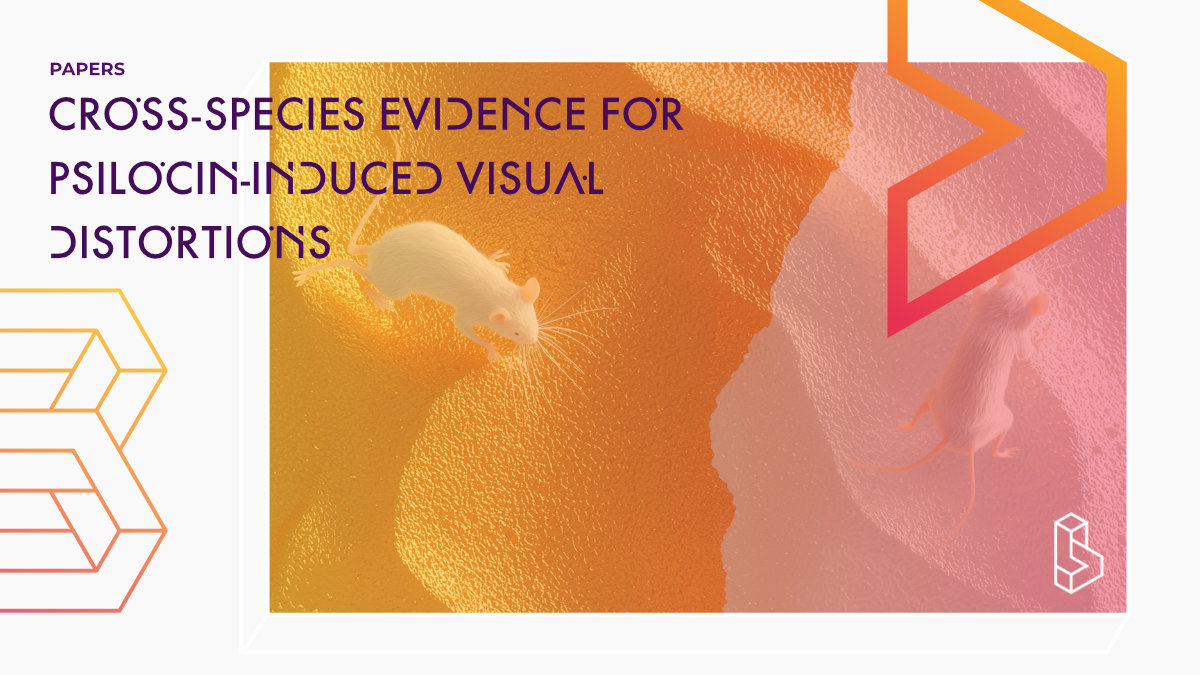This cross-species experimental study (n=21 humans; n=10 rats) finds that psilocin (18.2mg/70kg for humans; 0.3mg/kg for rats) impairs the ability to distinguish between static and moving images in both humans and rats. In humans, the impairment aligns with psilocin plasma levels and self-reported hallucination intensity. In rats, the effect is specific to motion perception, providing the first evidence of psilocin-induced visual distortions across species.
Abstract of Cross-Species Evidence for Psilocin-Induced Visual Distortions
“Background: Psychedelics, particularly psilocin, are increasingly being studied for their mind-altering effects and potential therapeutic applications in psychiatry. Visual hallucinations, especially the illusion of motion in static images, are a hallmark of their action. Despite growing interest, the underlying mechanisms remain poorly understood, as their systematic evaluation in both humans and animals is challenging.
Methods: To investigate psilocin-induced visual distortions, we designed a 2-choice visual discrimination task. Human participants and male rats indicated whether an image appeared static or moving while the image either actually moved or did not. In humans, performance was compared with self-reported hallucination intensity, Altered States of Consciousness scale scores, and psilocin plasma levels. Rats were tested in 2 distinct tasks, a luminance-based task and a motion-based task. Their performance was evaluated alongside decision time.
Results: Both species exhibited significant impairment in distinguishing static from dynamic visual stimuli while under psilocin’s influence. In humans, this impairment followed the time course of psilocin plasma levels and hallucination intensity. In rats, psilocin selectively impaired performance in the motion-based task, while performance in the luminance-based task remained intact, indicating a specific effect on visual perception. Decision time was linked to discrimination impairment.
Conclusions: Psilocin impaired static-dynamic discrimination in both species, providing the first evidence that rats experience visual distortions similar to those reported by humans. The correlations between discrimination impairment, psilocin levels, and hallucination intensity in humans reinforce psilocin’s effects on visual perception. This approach provides a valuable tool for investigating the neurobiology of altered visual perception in drug-induced states and psychiatric conditions.“
Authors: Čestmír Vejmola, Klára Šíchová, Kateřina Syrová, Lucie Janečková, Vlastimil Koudelka, Michael Tesař, Marek Nikolič, Michaela Viktorinová, Filip Tylš, Jakub Korčák, Vojtěch Viktorin, Eduard Kelemen, Tereza Nekovářová, Martin Brunovský, Jiří Horáček, Martin Kuchař & Tomáš Páleníček
Summary of Cross-Species Evidence for Psilocin-Induced Visual Distortions
The authors begin by addressing the visual hallucinations commonly induced by psychedelics, particularly psilocybin and its active metabolite, psilocin. These distortions frequently manifest as apparent motion in otherwise static images, a hallmark phenomenon reported by users. Psilocin primarily exerts its effects by stimulating the 5-HT2A serotonin receptor, which is densely located along the visual pathway in the brain. This receptor activation has been linked not only to drug-induced hallucinations but also to those occurring in psychiatric and neurodegenerative disorders such as schizophrenia and Parkinson’s disease. Despite growing recognition of these effects, the precise mechanisms driving psychedelic-induced visual changes remain poorly understood.
Psychedelics such as lysergic acid diethylamide (LSD), mescaline, DMT, and psilocin often evoke visual experiences in which stationary objects seem to move—described in terms such as “breathing”, “warping”, or “swirling”. At higher doses, these experiences intensify into vivid and immersive three-dimensional imagery. Tools like the Altered States of Consciousness (ASC) scale are commonly employed to assess such phenomena, and previous studies have shown dose-dependent relationships between psilocybin and the intensity of visual alterations.
Observations across animal species suggest that psychedelics may also trigger visual distortions in non-human brains. Behavioural changes—such as disoriented movement in pigs or head-twitch responses in mice—have long been noted, but systematic and objective measures of hallucinations in animals remain lacking. Notably, recent findings reveal that rats possess a more complex visual system than previously assumed, featuring processing pathways analogous to those in primates. This makes them promising candidates for translational studies of visual perception.
Methods and Materials
Human Experiment
Study Design and Participants
Find this paper
https://doi.org/10.1016/j.bpsgos.2025.100524
Open Access | Google Scholar | Backup | 🕊
Cite this paper (APA)
Vejmola, Č., Šíchová, K., Syrová, K., Janečková, L., Koudelka, V., Tesař, M., ... & Páleníček, T. (2025). Cross-Species Evidence for Psilocin-Induced Visual Distortions: Apparent Motion Is Perceived by Both Humans and Rats. Biological Psychiatry Global Open Science, 100524.
Study details
Compounds studied
Psilocybin
Placebo
Topics studied
Neuroscience
Study characteristics
Original
Placebo-Controlled
Double-Blind
Randomized
Animal Study
Bio/Neuro
Participants
21
Humans
Rodents
Compound Details
The psychedelics given at which dose and how many times
Psilocybin 18.2 mg | 1xLinked Clinical Trial
Animal and human serotonergic model of schizophrenia: validity evaluated by qEEG and fMRIThis trial (n=20) investigates the effects of psilocybin (18.2mg/70kg) on several brain measures and sleep quality.

